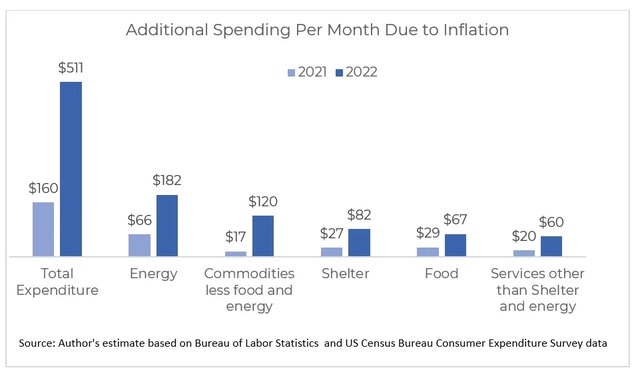
Rising Inflation Means Homebuyers Will Be Looking for Homes That Are $40,000 Cheaper
April 15, 2022
Inflation accelerated to 8.5% in March, the strongest pace in 40 years. With inflation running this high, the average consumer is spending $500 more compared to one year ago, or $6,132 annually. The higher spending on other consumer items means that the consumer will have less income to spend on a mortgage payment and will be looking for a home that is about $40,000 cheaper.

Prices of energy services and commodities rose at the steepest pace of 32% as energy commodities (fuel oil, motor oil including gas) spiked 48.2%. Energy accounted for nearly 8% of consumer spending. Nearly a third of the $500 additional spending is for energy services and commodities, at $182/month.
Prices of commodities other than food and energy rose 11.7%, with the largest increase in the cost of used cars/trucks (35.3%) and new vehicles (12.5%). This commodity group accounted for 22% of consumers spending.
Prices of food items rose 8.8%, with prices of food consumed at home rising at an even stronger pace of 10%. Food spending accounted for 12% of the average consumer spending.
Cost of shelter rose 5%, with rent on primary residence up 4.4% and the equivalent rent on owner-occupied housing up 4.5%. Asking rents based on proprietary data was up at a double-digit pace of 11% year-over-year.4 The largest consumer spending is on shelter, making up 32% of spending. Note that the price of housing is only factored in partially by way of the effect on mortgage rate payment that homeowners may want to recoup as rent if they rent out the home.
Services for expenditures other than energy services (shelter, medical care, transportation services) rose 4.7%. Airline fares, rose 24%. Spending for services other than energy services makes up 57% of consumer spending (including 32% for shelter).
Higher Inflation Means a Homebuyer Will Be Looking for a Home That Is $40,000 Cheaper
The increased cost of spending on other items impacts the ability of the average consumer to have enough leftover income to purchase a home. Excluding the cost of shelter, the average consumer is spending an additional $429 monthly for items other than shelter. Meanwhile, average weekly wages rose just $212 per month, so the consumer is short by $217 per month.
If we take the present value by applying a mortgage rate of 4.72% over 30 years, this means that the average consumer will be looking for a home that is $41,793 cheaper.
The dwindling supply of homes at below $250,000 makes it more difficult to find lower-priced homes. As of February 2022, homes prices at $250,000 and below accounted for just 29.5% of existing-home sales, down from 47.5% in January 2020.
With rising inflation, higher mortgage rates, and tight supply, housing demand is expected to decrease in 2022, to 10% according to NAR Chief Economist Lawrence Yun. However, prices are expected to still increase about 5% because of tight supply conditions.
Source: Rising Rising Inflation Means Homebuyers Will Be Looking for Homes That Are $40,000 Cheaper National Association of REALTORS® (April 13,2022) Scholastica Gay Cororaton